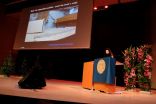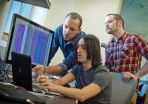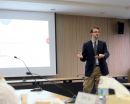(Press-News.org) CAMBRIDGE, MA -- MIT chemists have devised a new way to wirelessly detect hazardous gases and environmental pollutants, using a simple sensor that can be read by a smartphone.
These inexpensive sensors could be widely deployed, making it easier to monitor public spaces or detect food spoilage in warehouses. Using this system, the researchers have demonstrated that they can detect gaseous ammonia, hydrogen peroxide, and cyclohexanone, among other gases.
"The beauty of these sensors is that they are really cheap. You put them up, they sit there, and then you come around and read them. There's no wiring involved. There's no power," says Timothy Swager, the John D. MacArthur Professor of Chemistry at MIT. "You can get quite imaginative as to what you might want to do with a technology like this."
Swager is the senior author of a paper describing the new sensors in the Proceedings of the National Academy of Sciences the week of Dec. 8. Chemistry graduate student Joseph Azzarelli is the paper's lead author; other authors are postdoc Katherine Mirica and former MIT postdoc Jens Ravnsbaek.
Versatile gas detection
For several years, Swager's lab has been developing gas-detecting sensors based on devices known as chemiresistors, which consist of simple electrical circuits modified so that their resistance changes when exposed to a particular chemical. Measuring that change in resistance reveals whether the target gas is present.
Unlike commercially available chemiresistors, the sensors developed in Swager's lab require almost no energy and can function at ambient temperatures. "This would allow us to put sensors in many different environments or in many different devices," Swager says.
The new sensors are made from modified near-field communication (NFC) tags. These tags, which receive the little power they need from the device reading them, function as wirelessly addressable barcodes and are mainly used for tracking products such as cars or pharmaceuticals as they move through a supply chain, such as in a manufacturing plant or warehouse.
NFC tags can be read by any smartphone that has near-field communication capability, which is included in many newer smartphone models. These phones can send out short pulses of magnetic fields at radio frequency (13.56 megahertz), inducing an electric current in the circuit on the tag, which relays information to the phone.
To adapt these tags for their own purposes, the MIT team first disrupted the electronic circuit by punching a hole in it. Then, they reconnected the circuit with a linker made of carbon nanotubes that are specialized to detect a particular gas. In this case, the researchers added the carbon nanotubes by "drawing" them onto the tag with a mechanical pencil they first created in 2012, in which the usual pencil lead is replaced with a compressed powder of carbon nanotubes. The team refers to the modified tags as CARDs: chemically actuated resonant devices.
When carbon nanotubes bind to the target gas, their ability to conduct electricity changes, which shifts the radio frequencies at which power can be transferred to the device. When a smartphone pings the CARD, the CARD responds only if it can receive sufficient power at the smartphone-transmitted radio frequencies, allowing the phone to determine whether the circuit has been altered and the gas is present.
Current versions of the CARDs can each detect only one type of gas, but a phone can read multiple CARDs to get input on many different gases, down to concentrations of parts per million. With the current version of the technology, the phone must be within 5 centimeters of the CARD to get a reading, but Azzarelli is currently working with Bluetooth technology to expand the range.
Widespread deployment
The researchers have filed for a patent on the sensing technology and are now looking into possible applications. Because these devices are so inexpensive and can be read by smartphones, they could be deployed nearly anywhere: indoors to detect explosives and other harmful gases, or outdoors to monitor environmental pollutants.
Once an individual phone gathers data, the information could be uploaded to wireless networks and combined with sensor data from other phones, allowing coverage of very large areas, Swager says.
The researchers are also pursuing the possibility of integrating the CARDs into "smart packaging" that would allow people to detect possible food spoilage or contamination of products. Swager's lab has previously developed sensors that can detect ethylene, a gas that signals ripeness in fruit.
The CARDs could also be incorporated into dosimeters to help monitor worker safety in manufacturing plants by measuring how much gas the workers are exposed to. "Since it's low-cost, disposable, and can easily interface with a phone, we think it could be the type of device that someone could wear as a badge, and they could ping it when they check in in the morning and then ping it again when they check out at night," Azzarelli says.
INFORMATION:
The research was funded by the U.S. Army Research Laboratory and the U.S. Army Research Office through the MIT Institute for Soldier Nanotechnologies; the MIT Deshpande Center for Technological Innovation; and the National Cancer Institute.
Written by Anne Trafton, MIT News Office
Researchers have long wondered if there is an upper limit to our capacity to store memories and how we manage to remember so many events without mixing up events that are very similar.
To explore this issue, researchers at the Norwegian University of Science and Technology's (NTNU) Kavli Institute for Systems Neuroscience and Centre for Neural Computation and colleagues from the Czech Republic and Italy tested the ability of rats to remember a number of distinct but similar locations. Their findings are published in the 8 December edition of the Proceedings of the National ...
Technology that can map out the genes at work in a snake or lizard's mouth has, in many cases, changed the way scientists define an animal as venomous. If oral glands show expression of some of the 20 gene families associated with "venom toxins," that species gets the venomous label.
But, a new study from The University of Texas at Arlington challenges that practice, while also developing a new model for how snake venoms came to be. The work, which is being published in the journal Molecular Biology and Evolution, is based on a painstaking analysis comparing groups of ...
(BOSTON and CAMBRIDGE, Massachusetts) - One of the reasons cancer is so deadly is that it can evade attack from the body's immune system, which allows tumors to flourish and spread. Scientists can try to induce the immune system, known as immunotherapy, to go into attack mode to fight cancer and to build long lasting immune resistance to cancer cells. Now, researchers at the Wyss Institute for Biologically Inspired Engineering and Harvard's School of Engineering and Applied Sciences (SEAS) show a non-surgical injection of programmable biomaterial that spontaneously assembles ...
BUFFALO, N.Y. - A new study has shown that smoking can inhibit the success of treatment for alcohol abuse, putting people who are addicted to both tobacco and alcohol in a double bind.
According to findings by the University at Buffalo Research Institute on Addictions (RIA), clients who smoke have shorter stays in alcohol treatment programs than non-smokers and may have poorer treatment outcomes than non-smokers.
Kimberly Walitzer, PhD, deputy director and senior research scientist at RIA, led the study, which analyzed more than 21,000 adult treatment seekers from ...
PROVIDENCE, R.I. - Some infections after prostate biopsy due to drug-resistant Escherichia coli can be thwarted by simple rectal swab cultures prior to the procedure. The cultures test for antibiotic-resistant E. coli, and the findings are used to direct the selection of antimicrobial prophylaxis used for the procedure, according to Rhode Island Hospital researchers. The study was recently published in Urology.
For patients undergoing transrectal ultrasound (TRUS)-guided biopsies, Ciprofloxacin may not be the best prophylactic option to use for patients colonized with ...
NASA's Terra and Aqua satellites flew over Typhoon Hagupit from Dec. 6 through Dec. 8 and the MODIS instrument that flies aboard both satellites provided images of the storm as it moved through the country.
The Moderate Resolution Imaging Spectroradiometer or MODIS instrument aboard NASA's Aqua satellite caught a picture of Hagupit on Dec. 6 before it made landfall. On Dec. 7, the MODIS instrument aboard NASA's Terra satellite took an image of the storm as it was making landfall in the eastern Philippines.
On Dec. 8 at 04:50 UTC (Dec. 7 at 11:50 p.m. EST) when NASA's ...
Scientists at the Medical College of Wisconsin (MCW) have discovered a link between sleep loss and cell injury. Results of a new study find sleep deprivation causes the damage to cells, especially in the liver, lung, and small intestine. Recovery sleep following deprivation heals the damage.
The findings are published in the December issue of Sleep, a joint publication of the Sleep Research Society and the American Academy of Sleep Medicine. The lead author is Carol Everson, Ph.D., professor of neurology, cell biology, neurobiology and anatomy at MCW. Co-authors are Christopher ...
Athens, Ga. - New University of Georgia research shows that while on the job, public servants contribute not just to mandated sustainability but also to discretionary eco-friendly initiatives of their own.
"Some people are born with a higher intrinsic need to serve the public," said study co-author Robert K. Christensen, an associate professor in the School of Public and International Affairs. "They have a desire to help others and serve society. Government and nonprofit managers, for example, typically have higher levels of public service motivation than business managers."
The ...
Triple-negative breast cancer is as bad as it sounds. The cells that form these tumors lack three proteins that would make the cancer respond to powerful, customized treatments. Instead, doctors are left with treating these patients with traditional chemotherapy drugs that only show long-term effectiveness in 20 percent of women with triple-negative breast cancer. Now, researchers at The Johns Hopkins University have discovered a way that breast cancer cells are able to resist the effects of chemotherapy -- and they have found a way to reverse that process.
A report of ...
CLEVELAND: Researchers from Seidman Cancer Center at University Hospitals (UH) Case Medical Center and Case Western Reserve University School of Medicine presented new research findings this weekend at the 56th Annual Meeting of the American Society of Hematology (ASH) in San Francisco.
In a poster presentation (Abstract #4053), Jane Little, MD, and colleagues presented promising findings related to a novel biochip aimed at improving outcomes for patients with sickle cell disease. Although it is well-known that red cell interactions are important in sickle cell disease, ...



